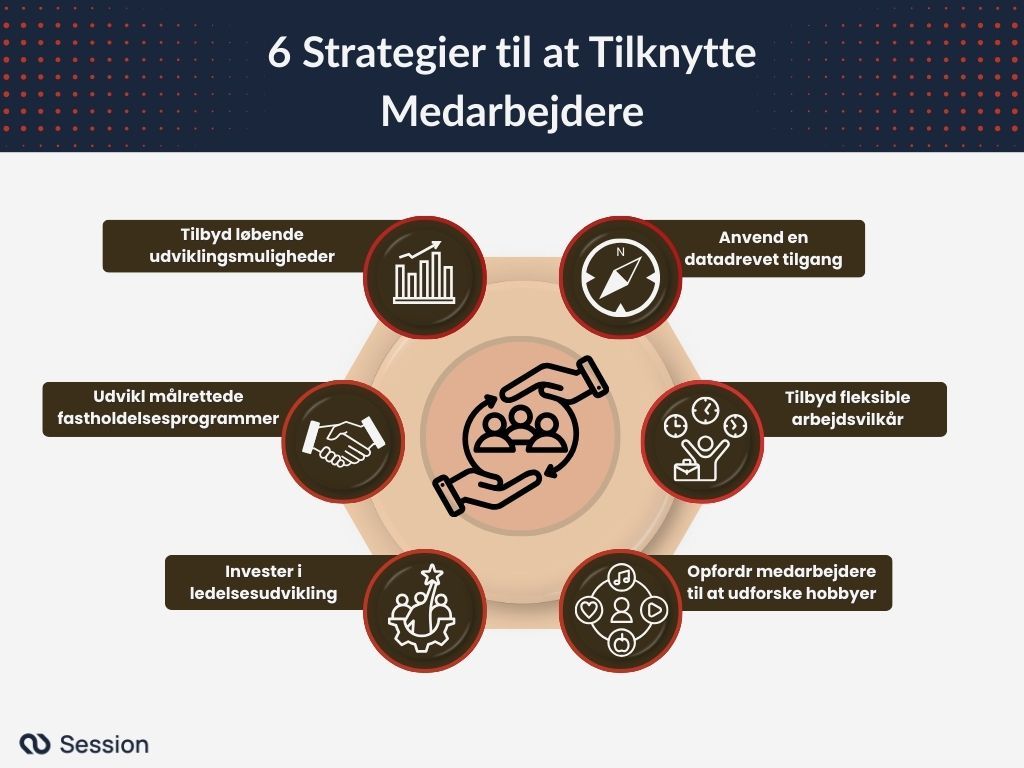I en tid med stigende medarbejdeomsætning og når der kæmpes om arbejdskraften, er det bydende nødvendigt, at organisationer fokuserer på fastholdelse. En ny undersøgelse konstaterer, at der i 2030 globalt vil mangle ca. 85 millioner mennesker i arbejdsstyrken. Og det er på trods af at vi lever i en tid, hvor teknologi erstatter mange stillinger! Vi er derfor nødt til at bygge organisationer, som mennesker virkelig ønsker at arbejde i. Det kræver at vi udvikler strategier som både kan tiltrække, men også fastholde medarbejderne.
Én tilgang er at tilbyde medarbejdere fordele og personalegoder. Men det, arbejdsgivere tror, medarbejderne vil have, stemmer ofte ikke overens med virkeligheden. Denne misforståelse kan i sig selv føre til opsigelser. Som ledelsescoach har jeg hørt begge sider: Ledere, der forsøger at fastholde medarbejdere – og medarbejdere, der overvejer at sige op. At forstå årsagerne bag den høje medarbejderomsætning er første skridt. I denne artikel gennemgår jeg både fastholdelsesstrategier og forklarer, hvordan talentudvikling spiller en vigtig rolle.
Hvilke faktorer bidrager til fratræden?
I forbindelse med corona-pandemien så vi et historisk højt antal opsigelser – det blev kaldt "The Great Resignation". Fænomenet fortsatte: Ifølge CNBC forlod næsten 4,2 millioner amerikanere frivilligt deres job i november 2023 – den 18. måned i træk med rekordhøje opsigelsesrater.
Særligt blandt yngre generationer (Gen Z og millennials) var tendensen tydelig – op mod 70 % overvejede at skifte job.
Her er nogle af de væsentligste årsager:
- Udbrændthed, overanstrengelse og mentale sundhedsproblemer. En tredjedel af medarbejderne – både ledere og ikke-ledere – sagde i en undersøgelse fra Inc.com, at de overvejede at skifte job på grund af deres mentale helbred. At passe på sig selv, og ikke at ville acceptere en kultur med overarbejde eller press - og et ønske om, at ens leder bekymrer sig om én, vægter højt!.
- Manglende engagement. Medarbejdere, der ikke føler sig engagerede i deres arbejde, er langt mere tilbøjelige til at søge nye jobmuligheder. Arbejdsengagement og trivsel hænger tæt sammen, så når engagementet falder, gør arbejdsglæden det også. Det er skadeligt for både mennesker og forretning – og skal tages alvorligt, hvis man vil fastholde medarbejdere på længere sigt.
- Manglende fleksibilitet og frihed. Pandemien førte til nye normer på arbejdspladsen med fokus på fjernarbejde og fleksible arbejdstider. Det har givet medarbejderne mulighed for at genoverveje deres prioriteter og præferencer. Organisationer, der ikke har tilpasset sig disse behov, oplever nu højere medarbejderomsætning.
- Manglende lærings- og udviklingsmuligheder. Medarbejdere vil lære og udvikle sig – det er et faktum. Organisationer, der behandler medarbejdere som tandhjul i et maskineri i stedet for som mennesker med behov for udvikling og støtte, mærker konsekvenserne af den stigende medarbejderflugt. Samtidig går de glip af det store potentiale, der kan frigøres, når medarbejdere får mulighed for løbende at udvikle sig.
- Manglende formål og en tydelig vision/mission. I de senere år har vi set en voksende bevidsthed om, hvad medarbejdere ønsker og har brug for – de søger arbejdspladser, der tilbyder meningsfyldt arbejde og har en klar vision eller mission, som de oprigtigt har lyst til at bidrage til.
- Dårlig ledelse og giftig arbejdskultur. Ledelse betyder noget! En undersøgelse viser, at hele 43 % af medarbejderne i Storbritannien på et tidspunkt har forladt et job på grund af en dårlig leder. En anden væsentlig årsag er en giftig arbejdskultur. En attraktiv kultur, hvor man føler sig værdsat, respekteret, tryg og har arbejdsglæde, er afgørende – og hvis den mangler, overvejer folk at sige op, eller har allerede gjort det.
- Utilstrækkelig eller uretfærdig løn. Ligeløn, fair og gennemsigtig aflønning bør være en prioritet i enhver organisation – men det er desværre langt fra altid tilfældet. Medarbejdere bliver i stigende grad bevidste om deres egen værdi, og hvis de ikke bliver betalt, hvad de fortjener eller med rimelighed kan forvente baseret på sammenlignelige stillinger, vælger de at forlade virksomheden.
I det næste afsnit ser vi på en mulig modvægt til den stigende medarbejderflugt: Talentudvikling.
Hvad er talentudvikling – og hvorfor er det vigtigt at investere i det?
Talentudvikling dækker over de indsatser, der fremmer læring, engagement, talenthåndtering og medarbejderudvikling med det formål at styrke organisationens performance, produktivitet og resultater. Det kan fungere som en drivkraft for organisatorisk succes ved at skabe processer, systemer og rammer, der understøtter strategier for træning og udvikling, planlægning af succession og læringsmuligheder.
Talentudvikling hjælper den enkelte med at finde energi og fokusere på at bringe det bedste frem i sig selv på arbejdspladsen. Det er afgørende, at organisationer udnytter og understøtter medarbejdernes styrker – og bringer dem i spil i teamsamarbejdet.
"Når vi tænker på talentudvikling, tænker vi på performance management; vi tænker på mål – ting på individniveau. Og det er ikke noget dårligt sted at starte. Men det reelle arbejde sker altid i samarbejde; det sker altid i samspil; det sker altid i teams." Marcus Buckingham
Fastholdelsesstrategier: Hvad virker rent faktisk?
Nu hvor vi har set på, hvorfor medarbejdere siger op, og hvad talentudvikling indebærer, er det tid til at se nærmere på selve indholdet i en effektiv fastholdelsesstrategi – og hvordan den kan omsættes til praksis. Fastholdelse begynder med en grundig forståelse af medarbejdernes behov. Organisationer, der tager sig tid til at forstå disse behov, vil have en klar fordel i kampen om at fastholde talent.
Lad os se på nogle gode strategier til fastholdelse.

1. Tag en datadrevet tilgang
Organisationer vil ikke kunne gennemføre effektive fastholdelsesstrategier, hvis de ikke forstår medarbejdernes behov. Derfor er det afgørende at indsamle feedback fra medarbejderne gennem målbare metoder. Arbejdsgivere bør tage en datadrevet tilgang til fastholdelse – data, der ikke kun viser, hvor mange der siger op, men også hvem der har størst risiko for at forlade virksomheden (f.eks. ud fra demografiske forhold), hvorfor folk forlader – og hvorfor de bliver – samt hvilke konkrete handlinger der kan iværksættes for at forebygge yderligere opsigelser.
2. Anvend skræddersyede fastholdelsesprogrammer
Fastholdelsesprogrammer kan hjælpe med at beskytte det mest værdifulde en organisation har: Mennesker. Men programmerne skal tage udgangspunkt i medarbejdernes reelle behov – ikke i antagelser om, hvad de har brug for. Der findes derfor ikke en “one-size-fits-all”-løsning. Det afhænger af den data, du har indsamlet – hvad viser den? Og når du spørger dine medarbejdere: Hvad ønsker de egentlig? Når dette er klarlagt, handler det om at tage handling og tilbyde programmer og initiativer, der imødekommer både individuelle, teammæssige og organisatoriske behov.
3. Giv medarbejderne løbende udviklingsmuligheder
Dygtige medarbejdere ønsker at udvikle sig gennem hele deres karriere – og organisationer, der understøtter denne udvikling, vil opleve højere fastholdelse. Udvikling er ikke længere et ekstra personalegode for de få – det forventes nu af talentfulde medarbejdere og en nødvendighed for fremtidens organisationer. Livslang læring og kompetenceudvikling hjælper ikke kun med at lukke talentgabet – det tiltrækker og fastholder også medarbejdere, der aktivt søger arbejdspladser, hvor man investerer i mennesker og tager deres læringsbehov alvorligt.
4. Tilbyd fleksible arbejdsforhold
Mange medarbejdere kæmper med at få arbejdsliv og privatliv til at hænge sammen – og som tidligere nævnt påvirker det også deres mentale sundhed. Fleksible arbejdsforhold har vist sig at være en effektiv strategi til fastholdelse, og det står nu klart, at hybrid- og fjernarbejde er kommet for at blive. Selv hvis din organisation ikke kan tilbyde hjemmearbejde, kan du give medarbejderne større frihed og indflydelse på, hvordan de tilrettelægger deres arbejde.
En af mine klienter, en leder i Indien, fortalte mig, at han har indført en daglig “blackout-periode”, hvor medarbejderne ikke skal stå til rådighed for nogen. De kan bruge tiden på hvad som helst – yoga, børnepasning, madlavning – helt uden spørgsmål. Resultatet? 0 % medarbejderafgang under hele covid-pandemien. Det siger noget om, hvor stor betydning fleksibilitet har for medarbejdernes loyalitet.
5. Invester i ledelsesudvikling
Der er et ordsprog, der siger, at folk ikke forlader virksomheder – de forlader dårlige ledere. Og selvom det ikke er den eneste grund til, at medarbejdere søger nye muligheder, er det en væsentlig faktor for mange. God ledelse og de rette udviklingsprogrammer er afgørende – både for organisationens resultater og retning og for medarbejdernes trivsel, engagement og produktivitet.
Det er vigtigt, at ledere har de rette kompetencer til at lede mennesker og teams – og at de kan skabe en sund feedback- og arbejdskultur. Empati og opmærksomhed i ledelse har større betydning for fastholdelse, end man måske tror, og undersøgelser viser, at særligt yngre generationer aktivt søger ledere, der viser, at de virkelig bekymrer sig.
6. Støt medarbejderne i at dyrke deres fritidsinteresser
Endnu en vigtig – og ofte overset – brik i fastholdelsespuslespillet handler om medarbejdernes fritidsinteresser uden for arbejdet. På en workshop, hvor jeg sammen med ledere diskuterede, hvordan man fastholder medarbejdere, dukkede et interessant perspektiv op: Mange bliver mere optagede af deres hobbyer og får en stærkere identitet uden for jobbet. For mange er det nyt – vi har i årevis ladet vores jobtitler definere, hvem vi er.
En deltager fortalte mig, hvordan hun havde udviklet en passion for madlavning gennem eksotiske opskrifter på YouTube og nu overvejede at starte en weekendbaseret madleveringsservice. Hun sagde, at hvis det tog fart, ville hun måske sige sit fuldtidsjob op. Jeg spurgte: “Hader du dit arbejde?”, og hun svarede: “Nej, jeg elsker det – og hvis jeg kunne finde en måde at gøre begge dele, ville jeg elske det.” Jeg foreslog, at hun talte med sin leder om at skrue ned for sin nuværende arbejdsbyrde. Hun svarede straks: “Han vil ikke lytte.”
Manglende støtte til folks fritidsinteresser og passioner underminerer fastholdelse. Tværtimod – det skubber folk væk.
Konklusion
Et stigende antal medarbejdere siger op – eller overvejer det. Organisationer, der tager sig tid til at forstå hvorfor, handler derefter og investerer i talentudvikling og målrettede fastholdelsesprogrammer, vil stå med en klar konkurrencefordel. Medarbejdere, der ikke føler sig værdsat eller investeret i, bliver med tiden utilfredse – og det er netop de utilfredse medarbejdere, der er mest tilbøjelige til at forlade organisationen.
“The Great Resignation” er en reel udfordring, men den nuværende omrokering på arbejdsmarkedet rummer også store muligheder. For at gribe dem må organisationer stoppe op, lytte, lære – og implementere de forandringer, som medarbejderne efterspørger.











